
Temple Israel is a historic synagogue located at Lafayette, Tippecanoe County, Indiana. Its 1867 building is one of the oldest synagogue buildings in the United States.

The Morrison Block, also known as M. O'Connor Grocery Wholesalers and Peoples Outfitting Building, is a historic commercial building located on South Meridian Street in Indianapolis, Indiana, United States. It was built about 1870, and is a four-story, Italianate style timber frame and masonry building. It features round arched windows and a projecting cornice. The building has been restored.
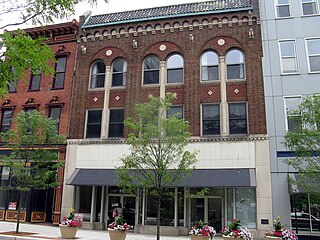
Kresge–Groth Building is a historic commercial building located in downtown Fort Wayne, Indiana. It was built in 1926, and is a three-story, three-bay, Spanish Colonial Revival style brick building. The front facade features three round-topped wall arches and two-story engaged limestone columns. The building originally housed the S. S. Kresge Company and after 1933 the Earl Groth Company. It was occupied by from 1964 to 1971 by Walgreen Drug Store.
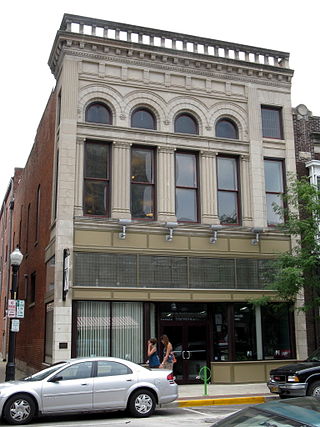
Louis Mohr Block is a historic commercial building located in downtown Fort Wayne, Indiana. It was built in 1891, and is a two-story, five-bay, Richardsonian Romanesque style brick building with a three-story rear addition erected in 1926. The front facade features cut limestone cladding on the upper part and round arch windows. The building was remodeled in 1963. For many years the building housed a women's clothing store, The Vogue.

The Journal-Gazette Building is a historic commercial building located in downtown Fort Wayne, Indiana. It was designed by noted Fort Wayne architect Charles R. Weatherhogg and built in 1927–1928. It is a four-story, 13 bay, red brick building with limestone trim in the Chicago Style. The seven central bays feature round arch window openings. For many years the building housed The Journal Gazette newspaper plant.
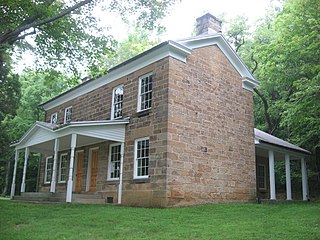
Jacob Rickenbaugh House is a historic home located in Hoosier National Forest, Oil Township, Perry County, Indiana. It was built in 1874, and is a two-story, "T"-plan dwelling constructed of ashlar sandstone blocks in the late Greek Revival style. It has a low pitched gable roof and side porches on each side of the rear ell. From 1870 to 1961, its parlor housed the Celina Post Office. It was acquired by the United States Forest Service in 1968.

Nester House, also known as the Family Grocerie, Union Hotel, and Riverplace, is a historic hotel located at Troy, Perry County, Indiana. It was built about 1863, and is a 2+1⁄2-story, sandstone block building, with a late 1870s or mid 1880s rear addition. It features a two tiered, full facade porch. Also on the property is a contributing one story, rectangular brick building that is believed to have been a bathhouse for the hotel. The building housed a hotel that served salesmen and other river travelers of late-19th and early-20th century. It ceased to be used as a hotel in the 1930s.
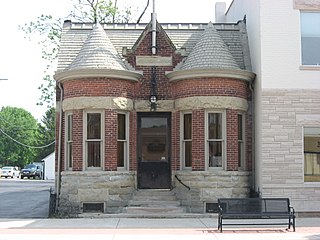
Fraser & Isham Law Office, also known as Christopher Law Office, is a historic law office building located at Fowler, Benton County, Indiana. It was built in 1896, and is a one-story, rectangular Romanesque Revival style red brick building. It features mansard and conical roofs and two rounded bays on the front facade. A flat roofed rear addition was erected in 1952.

Thorntown Public Library is a historic Carnegie library located at Thorntown, Boone County, Indiana. It was built in 1914–1915, and is a one-story, three-bay, brown brick building with a red clay tile hipped roof. It has a round arched entrance and limestone trim. Its construction was funded with $10,000 from the Carnegie Corporation of New York.

Boyce Block is a historic commercial building located at Muncie, Delaware County, Indiana. It was built in 1880, and is a two-story, brick building. The building features an elaborate parapet. Since 1904, the building has housed a theater.

Vincennes Fortnightly Club is a historic Women's club clubhouse located at Vincennes, Knox County, Indiana. It was built in 1928, and is a two-story, Colonial Revival style brick and Indiana limestone building. The tripartite front facade features arched openings and a decorative metal railed balcony on the second floor. The dumbbell shaped building consists of a main entrance block, auditorium, and rear stage section.

Louis Levey Mansion, also known as the Pilgrim Life Insurance Company Building, is a historic home located at Indianapolis, Indiana. It was built in 1905, and is a two-story, Italian Renaissance style limestone dwelling consisting of a three bay by four bay main block with a one bay by two bay rear block. It has a semicircular bay on the rear facade. The front facade features a round arched entrance flanked by pilasters and the roof is ringed by a balustrade. The house was converted for commercial uses in the 1950s.

Balmoral Court, also known as The Balmoral, is a historic apartment complex located at Indianapolis, Indiana. The complex was built in 1916, and consists of three, 2+1⁄2-story, Colonial Revival / Georgian Revival style townhouse blocks. The blocks are arranged around a central courtyard and are topped by gable roofs with dormers. The building at the end of the courtyard features a pedimented portico with Corinthian order columns.
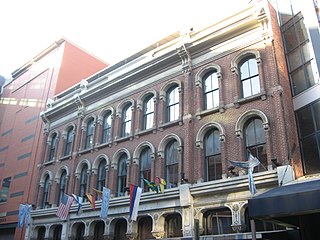
L.S. Ayres Annex Warehouse, also known as Elliott's Block Nos. 14-22, is a historic warehouse building located at Indianapolis, Indiana. It was built in 1875 by the L.S. Ayres department store, and is a three-story, rectangular Italianate style brick building with an elaborate cast iron first story storefront. Other decorative elements are in stone, brick, and sheet metal. It measures 72 feet, 6 inches, wide and 49 feet, 6 inches, deep. It features Corinthian order columns as part of the cast iron facade.

Hammond Block (Budnick's Trading Mart) is a historic commercial building located at Indianapolis, Indiana. It was built in 1874, and is a three-story, trapezoidal Italianate style red brick building on a limestone faced raised basement. It has a low hipped roof with a broad eave with a panelled frieze and bracketed cornice. It features cast iron decorative elements.

Washington Street–Monument Circle Historic District is a national historic district located at Indianapolis, Indiana, United States, covering the first two blocks of East and West Washington and Market streets, the south side of the 100 block of East Ohio Street, Monument Circle, the first block of North and South Meridian Street, the first two blocks of North Pennsylvania Street, the west side of the first two blocks of North Delaware Street, the east side of the first block of North Capitol Avenue, and the first block of North Illinois Street. In total, the district encompasses 40 contributing buildings and 2 contributing structures in the central business district of Indianapolis centered on Monument Circle. It developed between about 1852 and 1946, and includes representative examples of Italianate, Greek Revival, and Art Deco style architecture.

Vera and the Olga are two historic rowhouse blocks located at Indianapolis, Indiana. They were built in 1901, and are two-story, ten unit, red brick rows on a courtyard. Each building has a hipped roof and each unit is three bays wide. The buildings feature projecting bay windows and front porches.

William Buschmann Block, also known as the Buschmann Block, is a historic commercial building located at Indianapolis, Indiana. It was built in 1870–1871, and is a three-story, L-shaped, Italianate style brick building. It was enlarged with a four-story wing about 1879. It sits on a rubble foundation and has round arched openings with limestone lintels. The building originally housed a retail and wholesale grocery business.

General German Protestant Orphans Home, also known as the Pleasant Run Children's Home , is a historic orphanage located in Indianapolis, Indiana. It was designed by architect Diedrich A. Bohlen (1827–1890) and built in 1871–1872. It is a 2+1⁄2-story brick institutional building on a limestone block foundation. It has eclectic German vernacular detailing and varying roof forms.

Gaseteria, Inc., also known as ACLU, Indiana, historic apartment building located at Indianapolis, Indiana. It was built in 1941, and is a one-story, Art Moderne style, buff-color and red brick building with limestone detailing and a flat roof. It features curved walls and glass-block windows. It was built to house the offices of the Gaseteria filling station company.
























